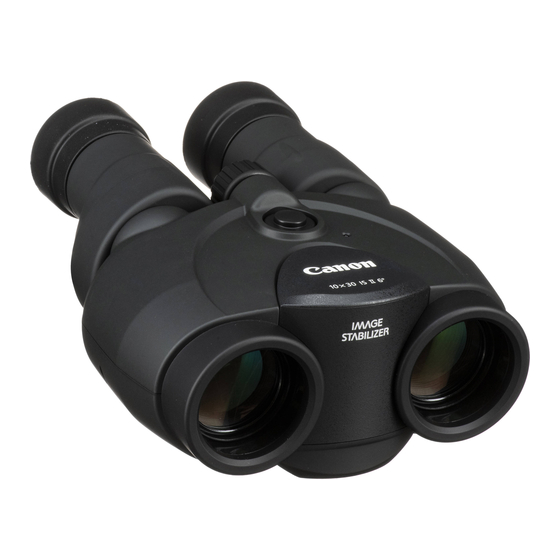Canon 10x30 IS II Handmatig - Pagina 14
Blader online of download pdf Handmatig voor {categorie_naam} Canon 10x30 IS II. Canon 10x30 IS II 25 pagina's. Technology guide
Ook voor Canon 10x30 IS II: Brochure & specificaties (8 pagina's), Brochure & specificaties (8 pagina's), Gebruikershandleiding (2 pagina's), Gebruiksaanwijzing (13 pagina's)

3) Does it seem as though the colors are running
together? How about discoloration?
When you look at a white object, a rainbow-type ring
appears. Called chromatic aberration, the image quality usually
decreases, and occurs with binoculars with larger apertures and
higher magnification (photo b). Also, because of the coating and
different lenses used for the binoculars, the colors may change.
Point the binoculars at a white image and check to see how
white the image is (photo c).
In order to prevent discoloration, Canon has adopted the
UD lens (15X50 IS ALL WEATHER, 18X50 IS ALL WEATHER)
from the EF lens series, which is known for its superior optical
technogy. In addition, with the "super spectra" coating, we
guarantee bright and clear images (photo d).
4) Is the entire image clear?
There are more binoculars with a wide field of view to meet
the demands of consumers. However, there are cases where the
binoculars were "forced" to have a wider field of view, which
causes the image quality around the edge of the lens to decrease.
When this happens, most of the time it is caused by curvature
of the field. Point the binoculars at a wall, focus on something
simple, and check if you can see clearly all round (photo e).
If the curvature of the field is large, the edges will be blurred.
It is not recommended to purchase such binoculars.
To greatly decrease the curvature of the field, Canon uses
a field-flattener lens and an aspherical lens. With Canon
binoculars, you will have beautiful image quality all round.
5) Is the image distorted?
When looking through the binoculars, there are times when the
perpendicular lines of windows of a building or bricks seem
warped around the edge of the lens (photo f). This is called
distortion. When the distortion is great, not only will the entire
object seem distorted, but when you move the binoculars, it will
seem as if the object were flowing, making it very hard to see.
Canon uses high-precision aspherical lenses to correct the
distortion.
